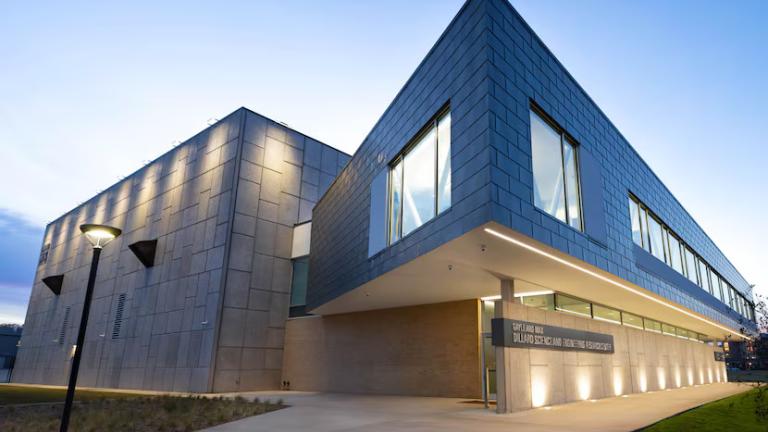
This story by MIT Environmental Solutions Journalism Fellow Philip Jankowski was originally published in the Dallas Morning News, where it appears with additional photos and resources.
Federal nuclear power regulators have given the go-ahead for the first research nuclear reactor in more than 40 years, and it’s here in Texas.
Abilene Christian University will be home to the advanced nuclear reactor, which the university’s NEXT Lab and Abilene-based nuclear company Natura Resources will build on campus. The permit from the Nuclear Regulatory Commission is a milestone in the research and development of smaller-scale nuclear reactors in Texas and could become the state’s first new nuclear reactor since the Comanche Peak power plant’s second unit was licensed to operate in 1993.
The NEXT Lab reactor could generate enough energy to power the equivalent of only about 250 homes. However, it will create a testing ground for a type of reactor that its developers believe can be scaled to larger utility-scale reactors.
It will be housed in the university’s Dillard Science and Engineering Research Center, which was completed in August 2023.
“With the NRC’s issuance of the construction permit, we are one step closer to making that a reality. The performance-driven approach of Natura Resources to advanced reactor deployment has quickly moved them from a relative unknown to a leader in the upstart advanced reactor industry,” said Phil Schubert, university president.
Federal inspectors will monitor the construction of the reactor, which will not produce electricity until ACU obtains additional federal approval to fuel the reactor with uranium.
“This is the first research reactor project we’ve approved for construction in decades, and the staff successfully worked with ACU to resolve several technical issues with this novel design,” Andrea Veil, director of the NRC’s Office of Nuclear Reactor Regulation, said in a news release.
Molten salt will be used to cool the reactor, which can reach extreme temperatures. Heat that radiates through the molten salt can then be used to create electricity.
While this method of cooling has existed for more than 50 years, it is not widely used. Legacy reactors generally rely on water to cool fuel rods.
According to Natura Resources, molten salt creates an additional level of safety. Because the salt vaporizes at temperatures far above the operating temperature of the proposed reactor, the molten salt remains at a much lower pressure than typical reactors. And any loss of containment would be stopped by the salt solidifying and trapping the uranium.
The Nuclear Regulatory Commission has given initial construction approval to one other moltensalt reactor, a Kairos Power facility in Albuquerque, N.M. ACU’s reactor will use liquid fuel — uranium dissolved in molten salt — compared to the Kairos’ planned use of solid uranium.
ACU is not the first Texas college with a nuclear facility. The University of Texas at Austin and Texas A&M University have on-campus nuclear reactors. Earlier this year, Texas A&M University System Chancellor John Sharp announced an effort to bring reactors to the system’s technology satellite campus in Bryan.
Douglass Robison, founder and president of Natura Resources, said the Nuclear Regulatory Commission is the “gold standard of licensing of nuclear reactors” and proves that larger, industrial-scale molten-salt reactors can be licensed in the U.S. Natura Resources said it hopes to scale the technology to 100-megawatt reactors, which could power about 25,000 homes.
“If we’re going to meet the growing energy needs, not only in the state of Texas but in our country and the world at large, we must begin deploying advanced nuclear reactors,” Robinson said in a news release.
The announcement of a new nuclear power reactor, even on a research scale, comes as the state’s political leadership has shown an increased appetite for the power source. Gov. Greg Abbott ordered state energy regulators to create a task force to examine the future of nuclear energy in Texas, including how to streamline a federal permitting process that can take years. Robison was named as a member of the task force.
Nuclear power emits virtually no carbon-based greenhouse gases, which are the leading cause of climate change.
Energy expert Doug Lewin cautioned that Texans should not be prepared to see a proliferation of new nuclear-generated power on the grid. The plants are costly and time-consuming to build.
“It’s really important for folks to understand that, if nuclear is going to scale in the state, it’s a 2030s thing, not a 2020s thing, like this is a one-megawatt reactor,” he said.
Dow Chemical and X-Energy are developing an advanced nuclear reactor at Dow’s Seadrift plant about 120 miles southwest of Houston on the Texas coast. The Department of Energy selected the project for up to $50 million in federal funding in 2023. It has yet to get a construction permit from the Nuclear Regulatory Commission.





